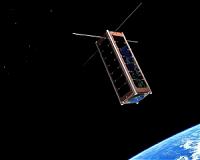 |
Greenbelt MD (SPX) Jul 26, 2010 The last of five instruments slated to fly on the upcoming NPOESS Preparatory Project (NPP) climate and weather satellite have been successfully integrated, according to NASA officials. The polar-orbiting satellite is scheduled to launch in late 2011. The NPP satellite was a pre-cursor mission to the National Polar-orbiting Operational Environmental Satellite System (NPOESS) that has recently been restructured. The last instrument, Cross-track Infrared Sounder (CrIS), is an advanced atmospheric sensor, built by ITT Corporation, Fort Wayne, Ind. Ball Aerospace and Technologies Corp., Boulder, Colo., built the NPP spacecraft and is performing the integration and checkout of the NPP satellite. The CrIS mechanical, electrical and performance testing was successfully completed and the NPP Satellite team is now working to finish the satellite Pre-Environmental Test baseline performance phase. The Environmental Test flow, which includes Dynamics, Electromagnetic Compatibility, and Thermal testing, is scheduled to begin this October. The five-instrument suite will collect and distribute remotely sensed land, ocean, and atmospheric data to the meteorological and global climate change communities. It will provide atmospheric and sea surface temperatures, humidity sounding, land and ocean biological productivity, cloud and aerosol properties and total/profile ozone measurements. Data produced by the CrIS instrument combined with data from the Advanced Technology Microwave Sounder, another NPP instrument, will provide global atmospheric temperature, moisture and pressure profiles from space. The other three instruments include: the Visible/Infrared Imager/Radiometer Suite, which will collect information about atmospheric clouds, the earth radiation budget, clear-air land/water surfaces, sea surface temperature, ocean color, and produces low light visible imagery; the Ozone Mapping and Profiler Suite, which will monitor ozone and continue the daily global data produced by the current ozone monitoring systems, but with higher fidelity and the Cloud and Earth Radiant Energy System that will measure the Earth's radiant energy balance and help researchers to develop improved weather forecasts and climate model predictions. The NPP mission is a NASA-managed project to provide continuity with NASA's Earth Observing System measurements and to provide risk reduction for the National Polar-orbiting Operational Environmental Satellite System (NPOESS) managed by the NPOESS Integrated Program Office, a tri-agency program made up of NASA, NOAA and the U.S. Department of Defense. However in 2010, due to cost overruns and delays, a task force led by the President's Office of Science and Technology Policy recommended against continuing NPOESS.
Share This Article With Planet Earth
Related Links NPOESS Preparatory Project (NPP) Space Technology News - Applications and Research
 Clyde Space To Build UK's First CubeSat
Clyde Space To Build UK's First CubeSatLondon, UK (SPX) Jul 26, 2010 The UK Space Agency has announced a one year pilot programme to design and launch a CubeSat - a miniature, cube-shaped satellite that will allow the UK to test new space technologies and carry out new space research 'cheaply' and quickly. The pilot programme, named UKube-1, will use the Clyde Space CubeSat platform and will involve a competition amongst companies and academic groups to com ... read more |
|
| The content herein, unless otherwise known to be public domain, are Copyright 1995-2010 - SpaceDaily. AFP and UPI Wire Stories are copyright Agence France-Presse and United Press International. ESA Portal Reports are copyright European Space Agency. All NASA sourced material is public domain. Additional copyrights may apply in whole or part to other bona fide parties. Advertising does not imply endorsement,agreement or approval of any opinions, statements or information provided by SpaceDaily on any Web page published or hosted by SpaceDaily. Privacy Statement |